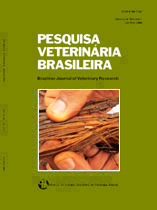 |
|
|
|
Year 2013 - Volume 33, Number 6
|

|
Reducing bumblefoot lesions in a group of captive Magellanic penguins (Spheniscus magellanicus) with the use of environmental enrichment, 33(6):791-795
|
ABSTRACT.- Reisfeld L., Barbirato M., Ippolito L., Cardoso R.C., Nichi M., Sgai M.G.F.G. & Pizzutto C.S. 2013. Reducing bumblefoot lesions in a group of captive Magellanic penguins (Spheniscus magellanicus) with the use of environmental enrichment. Pesquisa Veterinária Brasileira 33(6):791-795. Departamento de Reprodução Animal, Faculdade de Medicina Veterinária e Zootecnia, Universidade de São Paulo, Avenida Prof. Dr. Orlando Marques de Paiva 87, Cidade Universitária, São Paulo, SP 05508-270, Brazil. E-mail: lauravet@aquariodeaopaulo.com.br
Captive penguins are prone to pododermatitis (bumblefoot) lesions due to sedentary habits, changes in normal activity patterns, prolonged time on hard and abrasive surfaces, and less time swimming in the water. Environmental enrichment allows the use of creative and ingenious techniques that aim to keep the captive animals occupied by increasing the range and the diversity of behavioral opportunities always respecting the ethological needs of the species. The main goal of this work was to use environmental enrichment techniques to reduce pododermatitis in a group of captive penguins. Five captive Magellanic penguins (Spheniscus magellanicus) that were showing bumblefoot lesions were followed during this project. To monitor the lesions, all animals were physically restraint 3 times a week over a period of 12 weeks. Environmental enrichment was introduced daily in the water with the goal of enhancing their time in the water for one extra hour daily. The results demonstrate that in a twelve weeks period, four animals showed significant reduction of the lesions in both feet and in two animals the lesions were completely healed. With these results we can conclude that aquatic environmental enrichment allowed this group of penguins to spend more time in the water, favoring the reduction of the bumblefoot lesions. |
| |
|
|
| |
|
 |